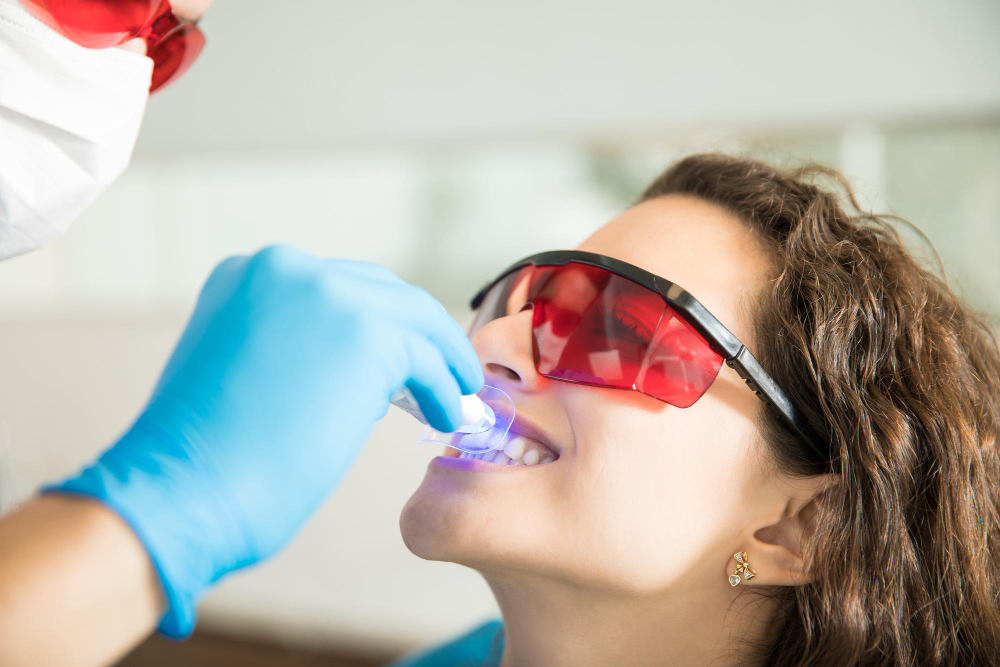A Modern Solution: Laser Treatment for Gum Disease Explained
When it comes to oral health concerns, laser treatment for gum disease ranks among the most common yet potentially serious conditions affecting American adults. This widespread condition not only threatens your smile but has been linked to numerous systemic health issues, including heart disease, diabetes, and respiratory problems.
Fortunately, modern dentistry continues to evolve, offering innovative solutions that make treatment more effective and comfortable than ever before. Laser treatment for gum disease represents one of the most significant advancements in periodontal care in recent decades, providing a less invasive alternative to traditional surgical approaches.
This guide explores how laser technology is revolutionizing laser treatment for gum disease.
Traditional Treatment Methods
Conventional approaches to treating gum disease include:
- Non-surgical treatments:
- Scaling and root planing (deep cleaning)
- Antibiotic treatments (local or systemic)
- Antimicrobial mouth rinses
- Surgical options:
- Flap surgery to access deeper pockets of infection
- Tissue and bone grafts to regenerate lost structures
- Guided tissue regeneration
While effective, these traditional methods often involve significant discomfort, bleeding, and extended recovery times. This is where laser treatment enters the picture as a game-changing alternative.
What Is Laser Treatment for Gum Disease?
Laser treatment for gum disease utilizes concentrated light energy to target and eliminate bacteria and unhealthy tissue while leaving healthy tissue intact. This precision makes it a revolutionary approach to periodontal therapy, providing better results with less trauma to surrounding tissues.
Types of Dental Lasers
Several types of lasers are used in periodontal care, each with specific applications:
- Diode Lasers:
- Work well on soft tissue
- Effective for killing bacteria
- Often used for minor gum reshaping and disinfection
- Nd: YAG Lasers:
- Penetrate deeper into tissues
- Excellent for removing diseased tissue
- Good coagulation properties to minimize bleeding
- Er: YAG and Er, Cr: YSGG Lasers:
- Can be used on both soft tissue and bone
- Less thermal damage to surrounding tissues
- Can remove tartar from root surfaces
- LANAP
The most advanced and well-researched laser protocol for gum disease is called Laser Assisted New Attachment Procedure (LANAP).
This specific laser operates at a wavelength targeting diseased tissue while sparing healthy gum tissue—a critical advantage over traditional methods.
The laser essentially “searches out” the darker pigmented, diseased tissue while leaving healthy tissue intact. This selective approach preserves more of your natural gum structure and promotes better healing.
Benefits of Laser Treatment for Gum Disease
The advantages of choosing laser therapy over traditional periodontal surgery are numerous and significant:
Less Invasive with Reduced Discomfort
One of the most appealing aspects of laser treatment is its minimally invasive nature:
- No cutting of healthy gum tissue with scalpels
- Significantly less bleeding during and after the procedure
- Less dental anxiety for patients who fear traditional surgery
More Precise Treatment
Laser technology offers unprecedented precision:
- Targets only diseased tissue, preserving healthy gum structure
- Minimizes collateral damage to surrounding tissues
- Allows treatment of areas that might be difficult to access with traditional instruments
Accelerated Healing Process
The biological response to laser energy contributes to faster healing:
- The sealed environment created by the blood clot promotes faster tissue regeneration
- Less open wound surface means reduced chance of post-operative infection
Reduced Risk of Infection
Laser treatment offers superior infection control:
- The laser inherently sterilizes as it works
- Kills bacteria that conventional methods might miss
- Creates a sealed, protected environment for healing
Preservation of Natural Teeth
Perhaps most importantly, advanced laser treatments like LANAP offer hope for teeth that might otherwise require extraction:
- Can be effective even in advanced periodontal cases
- May save teeth previously deemed “hopeless”
- Preserves more natural tooth structure
If you’re concerned about gum disease or have been told you need periodontal treatment, discussing laser options with a qualified gum disease specialist is recommended.
Remember that regardless of the treatment approach, early intervention is key to improving your oral health and preventing health issues.
Conclusion
Laser treatment for gum disease represents a significant advancement in dental care, offering patients a less invasive, more comfortable alternative to traditional periodontal surgery.
While not every case of periodontal disease is suitable for laser therapy, the technology provides valuable options for many patients who might otherwise avoid necessary treatment due to fear of conventional surgery.

